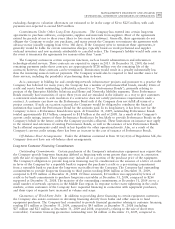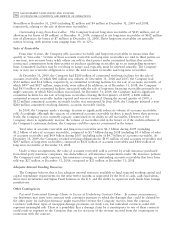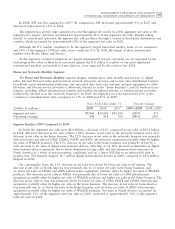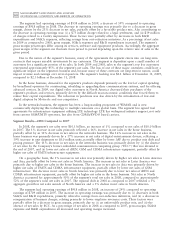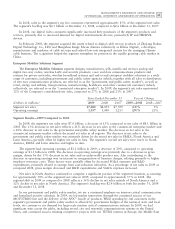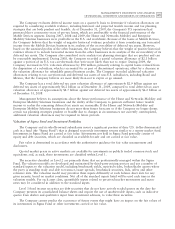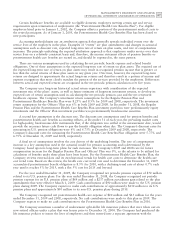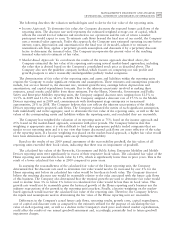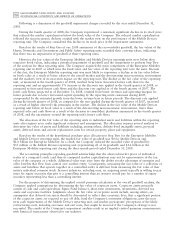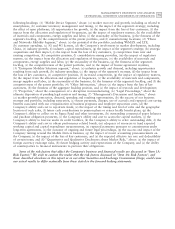Motorola 2009 Annual Report Download - page 73
Download and view the complete annual report
Please find page 73 of the 2009 Motorola annual report below. You can navigate through the pages in the report by either clicking on the pages listed below, or by using the keyword search tool below to find specific information within the annual report.
65
MANAGEMENT’S DISCUSSION AND ANALYSIS
OF FINANCIAL CONDITION AND RESULTS OF OPERATIONS
The Company evaluates deferred income taxes on a quarterly basis to determine if valuation allowances are
required by considering available evidence, including historical and projected taxable income and tax planning
strategies that are both prudent and feasible. As of December 31, 2009, the Company’s U.S operations had
generated three consecutive years of pre-tax losses, which are attributable to the financial performance of the
Mobile Devices segment. During 2007, 2008 and 2009, the Home and Networks Mobility and Enterprise
Mobility Solution businesses were profitable in the U.S. and worldwide. Because of the losses at Mobile Devices,
the Company believes that the weight of negative historical evidence precludes it from considering any forecasted
income from the Mobile Devices business in its analysis of the recoverability of deferred tax assets. However,
based on the sustained profits of the other businesses, the Company believes that the weight of positive historical
evidence allows it to include forecasted income from the other businesses in its analysis of the recoverability of its
deferred tax assets. The Company also considered in its analysis tax planning strategies that are prudent and can
be reasonably implemented. During 2008, the Company recorded a partial valuation allowance of $2.1 billion
against a portion of its U.S. tax carryforwards that were more likely than not to expire. During 2009, the
Company increased its U.S. valuation allowance by $90 million, primarily relating to capital losses realized from
the disposition of a subsidiary, which is accounted for as part of discontinued operations, offset by a decrease in
the valuation allowance for refundable general business credits. The Company recorded additional valuation
allowances relating to tax carryforwards and deferred tax assets of non-U.S. subsidiaries, including Brazil and
Mexico, that the Company believes are more likely than not to expire or go unused.
The Company has a total deferred tax asset valuation allowance of approximately $2.9 billion against net
deferred tax assets of approximately $6.2 billion as of December 31, 2009, compared to total deferred tax asset
valuation allowance of approximately $2.7 billion against net deferred tax assets of approximately $6.2 billion as
of December 31, 2008.
Management believes its assumptions about the future performance of the Home and Networks Mobility and
Enterprise Mobility Solutions businesses and the ability of the Company to generate sufficient future taxable
income to realize the remaining deferred tax assets are reasonable. If the Home and Networks Mobility and
Enterprise Mobility Solutions businesses do not meet these future forecasts or if the Company no longer deems
certain tax planning strategies prudent or feasible due to changes in circumstances not currently contemplated,
additional valuation allowances may be required in future periods.
Valuation of Sigma Fund and Investment Portfolios
The Company and its wholly-owned subsidiaries invest a significant portion of their U.S. dollar-denominated
cash in a fund (the ‘‘Sigma Fund’’) that is designed to provide investment returns similar to a money market fund.
Investments in Sigma Fund are carried at fair value. Investments not held in Sigma Fund generally consist of
equity and debt securities, which are classified as available-for-sale and are carried at fair value.
Fair value is determined in accordance with the authoritative guidance for fair value measurement and
disclosures.
Quoted market prices in active markets are available for investments in publicly traded common stock and
equivalents and, as such, these investments are classified within Level 1.
The securities classified as Level 2 are primarily those that are professionally managed within the Sigma
Fund. The valuation models are developed and maintained by third-party pricing services and use a number of
standard inputs to the valuation model, including benchmark yields, reported trades, broker/dealer quotes where
the party is standing ready and able to transact, issuer spreads, benchmark securities, bids, offers and other
reference data. The valuation model may prioritize these inputs differently at each balance sheet date for any
given security, based on market conditions. Not all of the standard inputs listed will be used each time in the
valuation models. For each asset class, quantifiable inputs related to perceived market movements and sector
news may be considered in addition to the standard inputs.
Level 3 fixed income securities are debt securities that do not have actively traded quotes on the date the
Company presents its consolidated balance sheets and require the use of unobservable inputs, such as indicative
quotes from dealers and qualitative input from investment advisors, to value these securities.
The Company cannot predict the occurrence of future events that might have an impact on the fair values of
its investments in Sigma Fund or other investments carried at fair value.


